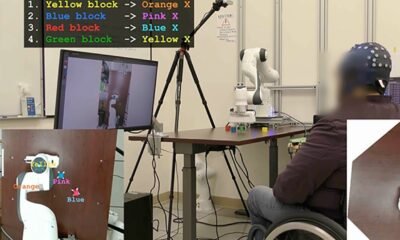AI Research
New AI tool predicts therapies to restore health in diseased cells Harvard Gazette

In a move that could reshape drug discovery, researchers at Harvard Medical School have designed an artificial intelligence model capable of identifying treatments that reverse disease states in cells.
Unlike traditional approaches that typically test one protein target or drug at a time in hopes of identifying an effective treatment, the new model, called PDGrapher and available for free, focuses on multiple drivers of disease and identifies the genes most likely to revert diseased cells back to healthy function.
The tool also identifies the best single or combined targets for treatments that correct the disease process. The work, described Tuesday in Nature Biomedical Engineering, was supported in part by federal funding.
By zeroing in on the targets most likely to reverse disease, the new approach could speed up drug discovery and design and unlock therapies for conditions that have long eluded traditional methods, the researchers noted.
“Traditional drug discovery resembles tasting hundreds of prepared dishes to find one that happens to taste perfect,” said study senior author Marinka Zitnik, associate professor of biomedical informatics in the Blavatnik Institute at HMS. “PDGrapher works like a master chef who understands what they want the dish to be and exactly how to combine ingredients to achieve the desired flavor.”
The new approach could speed up drug discovery and design and unlock therapies for conditions that have long eluded traditional methods.
The traditional drug-discovery approach — which focuses on activating or inhibiting a single protein — has succeeded with treatments such as kinase inhibitors, drugs that block certain proteins used by cancer cells to grow and divide. However, Zitnik noted, this discovery paradigm can fall short when diseases are fueled by the interplay of multiple signaling pathways and genes. For example, many breakthrough drugs discovered in recent decades — think immune checkpoint inhibitors and CAR T-cell therapies — work by targeting disease processes in cells.
The approach enabled by PDGrapher, Zitnik said, looks at the bigger picture to find compounds that can actually reverse signs of disease in cells, even if scientists don’t yet know exactly which molecules those compounds may be acting on.
How PDGrapher works: Mapping complex linkages and effects
PDGrapher is a type of artificial intelligence tool called a graph neural network. This tool doesn’t just look at individual data points but at the connections that exist between these data points and the effects they have on one another.
In the context of biology and drug discovery, this approach is used to map the relationship between various genes, proteins, and signaling pathways inside cells and predict the best combination of therapies that would correct the underlying dysfunction of a cell to restore healthy cell behavior. Instead of exhaustively testing compounds from large drug databases, the new model focuses on drug combinations that are most likely to reverse disease.
PDGrapher points to parts of the cell that might be driving disease. Next, it simulates what happens if these cellular parts were turned off or dialed down. The AI model then offers an answer as to whether a diseased cell would happen if certain targets were “hit.”
“Instead of testing every possible recipe, PDGrapher asks: ‘Which mix of ingredients will turn this bland or overly salty dish into a perfectly balanced meal?’” Zitnik said.
Advantages of the new model
The researchers trained the tool on a dataset of diseased cells before and after treatment so that it could figure out which genes to target to shift cells from a diseased state to a healthy one.
Next, they tested it on 19 datasets spanning 11 types of cancer, using both genetic and drug-based experiments, asking the tool to predict various treatment options for cell samples it had not seen before and for cancer types it had not encountered.
The tool accurately predicted drug targets already known to work but that were deliberately excluded during training to ensure the model did not simply recall the right answers. It also identified additional candidates supported by emerging evidence. The model also highlighted KDR (VEGFR2) as a target for non-small cell lung cancer, aligning with clinical evidence. It also identified TOP2A — an enzyme already targeted by approved chemotherapies — as a treatment target in certain tumors, adding to evidence from recent preclinical studies that TOP2A inhibition may be used to curb the spread of metastases in non-small cell lung cancer.
The model showed superior accuracy and efficiency, compared with other similar tools. In previously unseen datasets, it ranked the correct therapeutic targets up to 35 percent higher than other models did and delivered results up to 25 times faster than comparable AI approaches.
What this AI advance spells for the future of medicine
The new approach could optimize the way new drugs are designed, the researchers said. This is because instead of trying to predict how every possible change would affect a cell and then looking for a useful drug, PDGrapher right away seeks which specific targets can reverse a disease trait. This makes it faster to test ideas and lets researchers focus on fewer promising targets.
“Our ultimate goal is to create a clear road map of possible ways to reverse disease at the cellular level.”
Marinka Zitnik, Blavatnik Institute
This tool could be especially useful for complex diseases fueled by multiple pathways, such as cancer, in which tumors can outsmart drugs that hit just one target. Because PDGrapher identifies multiple targets involved in a disease, it could help circumvent this problem.
Additionally, the researchers said that after careful testing to validate the model, it could one day be used to analyze a patient’s cellular profile and help design individualized treatment combinations.
Finally, because PDGrapher identifies cause-effect biological drivers of disease, it could help researchers understand why certain drug combinations work — offering new biological insights that could propel biomedical discovery even further.
The team is currently using this model to tackle brain diseases such as Parkinson’s and Alzheimer’s, looking at how cells behave in disease and spotting genes that could help restore them to health. The researchers are also collaborating with colleagues at the Center for XDP at Massachusetts General Hospital to identify new drug targets and map which genes or pairs of genes could be affected by treatments for X-linked Dystonia-Parkinsonism, a rare inherited neurodegenerative disorder.
“Our ultimate goal is to create a clear road map of possible ways to reverse disease at the cellular level,” Zitnik said.
The work was funded in part by federal grants from the National Institutes of Health, National Science Foundation CAREER Program, the U.S. Department of Defense, and the ARPA-H Biomedical Data Fabric program, as well as awards from the Chan Zuckerberg Initiative, the Gates Foundation, Amazon Faculty Research, Google Research Scholar Program, AstraZeneca Research, Roche Alliance with Distinguished Scientists, Sanofi iDEA-iTECH, Pfizer Research, John and Virginia Kaneb Fellowship at HMS, Biswas Computational Biology Initiative in partnership with the Milken Institute, HMS Dean’s Innovation Awards for the Use of Artificial Intelligence, Harvard Data Science Initiative, and the Kempner Institute for the Study of Natural and Artificial Intelligence at Harvard University. Partial support was received from the Summer Institute in Biomedical Informatics at HMS and from the ERC-Consolidator Grant.
Source link
AI Research
New AI study aims to predict and prevent sinkholes in Tennessee’s vulnerable roadways

CHATTANOOGA, Tenn — A large sinkhole that appeared on Chattanooga’s Northshore after last month’s historic flooding is just the latest example of roadway problems that are causing concern for drivers.
But a new study looks to use artificial intelligence (AI) to predict where these sinkholes will appear before they do any damage.
“It’s pretty hard to go about a week without hearing somebody talking about something going wrong with the road.”
According to the American Geoscience Institute, sinkholes can have both natural and artificial causes.
However, they tend to occur in places where water can dissolve bedrock, making Tennessee one of the more sinkhole prone states in the country.
Brett Malone, CEO of UTK’s research park, says…
“Geological instability, the erosions, we have a lot of that in East Tennessee, and so a lot of unsteady rock formations underground just create openings that then eventually sort of cave in.”
Sinkholes like the one on Heritage Landing Drive have become a serious headache for drivers in Tennessee.
Nearby residents say its posed safety issues for their neighborhood.
Now, UTK says they are partnering with tech company TreisD to find a statewide solution.
The company’s AI technology could help predict where a sinkhole forms before it actually happens.
“You can speed up your research. So since we’ve been able to now use AI for 3D images, it means we get to our objective and our goals much faster.”
TreisD founder Jerry Nims says their AI algorithm uses those 3D images to study sinkholes in the hopes of learning ways to prevent them.
“If you can see what you’re working with, the experts, and they can gain more information, more knowledge, and it’ll help them in their decision making.”
We asked residents in our area, like Hudson Norton, how they would feel about a study like this in our area.
“If it’s helping people and it can save people, then it sounds like a good use of AI, and responsible use of it, more importantly.”
Chattanooga officials say the sinkhole on Heritage Landing Drive could take up to 6 months to repair.
AI Research
New Study Reveals Challenges in Integrating AI into NHS Healthcare

Implementing artificial intelligence (AI) within the National Health Service (NHS) has emerged as a daunting endeavor, revealing significant challenges rarely anticipated by policymakers and healthcare leaders. A recent peer-reviewed qualitative study conducted by researchers at University College London (UCL) sheds light on the complexities involved in the procurement and early deployment of AI technologies tailored for diagnosing chest conditions, particularly lung cancer. The study surfaces amidst a broader national momentum aimed at integrating digital technology within healthcare systems as outlined in the UK Government’s ambitious 10-year NHS plan, which identifies digital transformation as pivotal for enhancing service delivery and improving patient experiences.
As artificial intelligence gains traction in healthcare diagnostics, NHS England launched a substantial initiative in 2023, whereby AI tools were introduced across 66 NHS hospital trusts, underpinned by a notable funding commitment of £21 million. This ambitious project aimed to establish twelve imaging diagnostic networks that could expand access to specialist healthcare opinions for a greater number of patients. The expected functionalities of these AI tools are significant, including prioritizing urgent cases for specialist review and assisting healthcare professionals by flagging abnormalities in radiological scans—tasks that could potentially ease the burden on overworked NHS staff.
However, two key aspects have emerged from this research, revealing that the rollout of AI systems has not proceeded as swiftly as NHS leadership had anticipated. Building on evidence gleaned from interviews with hospital personnel and AI suppliers, the UCL team identified procurement processes that were unanticipatedly protracted, with delays stretching from four to ten months beyond initial schedules. Strikingly, by June 2025—18 months post-anticipated completion—approximately a third of the participating hospital trusts had yet to integrate these AI tools into clinical practice. This delay emphasizes a critical gap between the technological promise of AI and the operational realities faced by healthcare institutions.
Compounding these challenges, clinical staff equipped with already high workloads have found it tough to engage wholeheartedly with the AI project. Many staff members expressed skepticism about the efficacy of AI technologies, rooted in concerns about their integration with existing healthcare workflows, and the compatibility of new AI tools with aging IT infrastructures that vary widely across numerous NHS hospitals. The researchers noted that many frontline workers struggled to perceive the full potential of AI, especially in environments that overly complicated the procurement and implementation processes.
In addition to identifying these hurdles, the study underscored several factors that proved beneficial in the smooth embedding of AI tools. Enthusiastic and committed local hospital teams played a significant role in facilitating project management, and strong national leadership was critical in guiding the transition. Hospitals that employed dedicated project managers to oversee the implementation found their involvement invaluable in navigating bureaucratic obstacles, indicating a clear advantage to having directed oversight in challenging integrations.
Dr. Angus Ramsay, the study’s first author, observed the lessons highlighted by this investigation, particularly within the context of the UK’s push toward digitizing the NHS. The study advocates for a recalibrated approach towards AI implementation—one that considers existing pressures within the healthcare system. Ramsay noted that the integration of AI technologies, while potentially transformative, requires tempered expectations regarding their ability to resolve deep-rooted challenges within healthcare services as policymakers might wish.
Throughout the evaluation, which spanned from March to September of last year, the research team analyzed how different NHS trusts approached AI deployment and their varied focal points, such as X-ray and CT scanning applications. They observed both the enthusiasm and the reluctance among staff to adapt to this novel technology, with senior clinical professionals expressing reservations over accountability and decision-making processes potentially being handed over to AI systems without adequate human oversight. This skepticism highlighted an urgent need for comprehensive training and guidance, as current onboarding processes were often inadequate for addressing the query-laden concerns of employees.
The analysis conducted by the UCL-led research team revealed that initial challenges, such as the overwhelming amount of technical information available, hampered effective procurement. Many involved in the selection process struggled to distill and comprehend essential elements contained within intricate AI proposals. This situation suggests the utility of establishing a national shortlist of approved AI suppliers to streamline procurement processes at local levels and alleviate the cognitive burdens faced by procurement teams.
Moreover, the emergence of widespread enthusiasm in some instances provided a counterbalance to initial skepticism. The collaborative nature of the imaging networks was particularly striking; team members freely exchanged knowledge and resources, which enriched the collective expertise as they navigated the implementation journey. The fact that many hospitals had staff committed to fostering interdepartmental collaboration made a substantial difference, aiding the mutual learning process involved in the integration of AI technologies.
One of the most pressing findings from the study was the realization that AI is unlikely to serve as a “silver bullet” for the multifaceted issues confronting the NHS. The variability in clinical requirements among the numerous organizations that compose the NHS creates an inherently complicated landscape for the introduction of diagnostic tools. Professor Naomi Fulop, a senior author of the study, emphasized that the diversity of clinical needs across numerous agencies complicates the implementation of diagnostic systems that can cater effectively to everyone. Lessons learned from this research will undoubtedly inform future endeavors in making AI tools more accessible while ensuring the NHS remains responsive to its staff and patients.
Moving forward, an essential next step will involve evaluating the use of AI tools post-implementation, aiming to understand their impact once they have been fully integrated into clinical operations. The researchers acknowledge that, while they successfully captured the procurement and initial deployment stages, further investigation is necessary to assess the experiences of patients and caregivers, thereby filling gaps in understanding around equity in healthcare delivery with AI involvement.
The implications of this study are profound, shedding light on the careful considerations necessary for effective AI introduction within healthcare systems, underscoring the urgency of embedding educational frameworks that equip staff not just with operational knowledge, but with an understanding of the philosophical, ethical, and practical nuances of AI in medicine. This nuanced understanding is pivotal as healthcare practitioners prepare for a future increasingly defined by technological integration and automation.
Faculty members involved in this transformative study, spanning various academic and research backgrounds, are poised to lead this critical discourse, attempting to bridge the knowledge gap that currently exists between technological innovation and clinical practice. As AI continues its trajectory toward becoming an integral part of healthcare, this analysis serves as a clarion call for future studies that prioritize patient experience, clinical accountability, and healthcare equity in the age of artificial intelligence.
Subject of Research: AI tools for chest diagnostics in NHS services.
Article Title: Procurement and early deployment of artificial intelligence tools for chest diagnostics in NHS services in England: A rapid, mixed method evaluation.
News Publication Date: 11-Sep-2025.
Web References: –
References: –
Image Credits: –
Keywords
AI, NHS, healthcare, diagnostics, technology, implementation, policy, research, patient care, digital transformation.
Tags: AI integration challenges in NHS healthcareAI tools for urgent case prioritizationartificial intelligence in lung cancer diagnosiscomplexities of AI deployment in healthcareenhancing patient experience with AIfunding for AI in NHS hospitalshealthcare technology procurement difficultiesNHS digital transformation initiativesNHS imaging diagnostic networksNHS policy implications for AI technologiesrole of AI in improving healthcare deliveryUCL research on AI in healthcare
AI Research
Fight AI-powered cyber attacks with AI tools, intelligence leaders say

Cyber defenders need AI tools to fend off a new generation of AI-powered attacks, the head of the National Geospatial-Intelligence Agency said Wednesday.
“The concept of using AI to combat AI attack or something like that is very real to us. So this, again, is commanders’ business. You need to enable your [chief information security officer] with the tools that he or she needs in order to employ AI to properly handle AI-generated threats,” Vice Adm. Frank Whitworth said at the Billington Cybersecurity Summit Wednesday.
Artificial intelligence has reshaped cyber, making it easier for hackers to manipulate data and craft more convincing fraud campaigns, like phishing emails used in ransomware attacks.
Whitworth spoke a day after Sean Cairncross, the White House’s new national cyber director, called for a “whole-of-nation” approach to ward off foreign-based cyberattacks.
“Engagement and increased involvement with the private sector is necessary for our success,” Cairncross said Tuesday at the event. “I’m committed to marshalling a unified, whole-of-nation approach on this, working in lockstep with our allies who share our commitment to democratic values, privacy and liberty…Together, we’ll explore concepts of operation to enable our extremely capable private sector, from exposing malign actions to shifting adversaries’ risk calculus and bolstering resilience.”
The Pentagon has been incorporating AI, from administrative tasks to combat. The NGA has long used it to spot and predict threats; use of its signature Maven platform has doubled since January and quadrupled since March 2024.
But the agency is also using “good old-fashioned automation” to more quickly make the military’s maps.
“This year, we were able to produce 7,500 maps of the area involving Latin America and a little bit of Central America…that would have been 7.5 years of work, and we did it in 7.5 weeks,” Whitworth said. “Sometimes just good old-fashioned automation, better practices of using automation, it helps you achieve some of the speed, the velocity that we’re looking for.”
The military’s top officer also stressed the importance of using advanced tech to monitor and preempt modern threats.
“There’s always risk of unintended escalation, and that’s what’s so important about using advanced tech tools to understand the environment that we’re operating in and to help leaders see and sense the risk that we’re facing. And there’s really no shortage of those risks right now,” said Gen. Dan Caine, chairman of the Joint Chiefs of Staff, who has an extensive background in irregular warfare and special operations, which can lean heavily on cutting-edge technologies.
“The fight is now centered in many ways around our ability to harvest all of the available information, put it into an appropriate data set, stack stuff on top of it—APIs and others—and end up with a single pane of glass that allows commanders at every echelon…to see that, those data bits at the time and place that we need to to be able to make smart tactical, operational and strategic decisions that will allow us to win and dominate on the battlefields of the future. And so AI is a big part of that,” Caine said.
The Pentagon recently awarded $200 million in AI contracts while the Army doubled down on its partnership with Palantir with a decade-long contract potentially worth $10 billion. The Pentagon has also curbed development of its primary AI platform, Advana, and slashed staff in its chief data and AI office with plans of a reorganization that promises to “accelerate Department-wide AI transformation” and make the Defense Department “an AI-first enterprise.”
-

 Business2 weeks ago
Business2 weeks agoThe Guardian view on Trump and the Fed: independence is no substitute for accountability | Editorial
-
Tools & Platforms4 weeks ago
Building Trust in Military AI Starts with Opening the Black Box – War on the Rocks
-

 Ethics & Policy2 months ago
Ethics & Policy2 months agoSDAIA Supports Saudi Arabia’s Leadership in Shaping Global AI Ethics, Policy, and Research – وكالة الأنباء السعودية
-

 Events & Conferences4 months ago
Events & Conferences4 months agoJourney to 1000 models: Scaling Instagram’s recommendation system
-

 Jobs & Careers2 months ago
Jobs & Careers2 months agoMumbai-based Perplexity Alternative Has 60k+ Users Without Funding
-

 Education2 months ago
Education2 months agoVEX Robotics launches AI-powered classroom robotics system
-

 Podcasts & Talks2 months ago
Podcasts & Talks2 months agoHappy 4th of July! 🎆 Made with Veo 3 in Gemini
-

 Education2 months ago
Education2 months agoMacron says UK and France have duty to tackle illegal migration ‘with humanity, solidarity and firmness’ – UK politics live | Politics
-

 Funding & Business2 months ago
Funding & Business2 months agoKayak and Expedia race to build AI travel agents that turn social posts into itineraries
-

 Podcasts & Talks2 months ago
Podcasts & Talks2 months agoOpenAI 🤝 @teamganassi



















